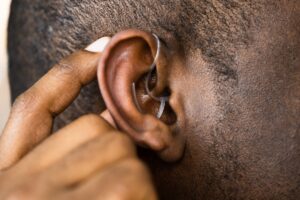Hearing aids are used by more than 2.5 million people who have trouble hearing, and it’s not surprising – they are a valuable tool for people with hearing loss.
Still, there are certain situations where they may need to perform better. That’s where hearing aid-compatible assistive listening devices can help. These devices are specifically designed to work with hearing aids, and they can make it easier to hear in challenging environments.
How assistive listening devices complement your hearing aids
Assistive listening devices can be a great supplement to hearing aids because they can help to improve hearing and communication in certain situations. For example, assistive listening devices can make hearing easier in noisy environments, such as restaurants or crowded public spaces. They can also help improve hearing on the phone or TV.
Additionally, assistive listening devices can be helpful for people with tinnitus, which is a condition where you hear ringing or other noises in your ears. Tinnitus devices can help mask the ringing noise, making it easier to concentrate and sleep.
Another benefit of assistive listening devices is that they can be personalized to your specific needs and preferences. For example, you can choose the best machine for your hearing loss and lifestyle. This can help ensure that you get the most benefit from the device and that you can use it effectively.
Types of assistive listening devices.
FM systems
FM systems, also known as frequency modulation systems, use radio frequency technology to improve the sound quality of audio signals for people with hearing loss. They are commonly used with hearing aids to make it easier for individuals to listen and understand speech in noisy environments.
Here’s how FM systems work: a small microphone is worn by the person speaking, and this microphone transmits the audio signal to a receiver attached to the hearing aid. The receiver then converts the radio signal back into an audio signal. It amplifies it so that the person with hearing loss can hear it more clearly.
T-coils
T-coils, called telecoils or induction loops, are small devices built into many hearing aids. By using electromagnetic induction, they allow the hearing aid to pick up sound from a nearby source, such as a telephone or a microphone in a public space. This can be useful for people who have difficulty hearing in noisy environments or on the phone, as it allows them to hear the source directly rather than trying to pick it up through the air.
To use a T-coil with a hearing aid, the person will first need to switch their hearing aid to the “T” setting. They can then use the hearing aid to pick up sound from a device connected to a loop system, a type of audio system that uses an electromagnetic field to transmit sound. This can be a public address system in a building, a phone, or any device equipped with a loop system.
Other assistive listening devices include:
Alerting devices: These devices can be helpful for people with hearing loss who need extra help with hearing alarms or other important sounds. For example, a doorbell alerting device can be connected to your hearing aid and vibrate or flash a light when the doorbell rings. This can be particularly helpful if you have trouble hearing the doorbell or are in a noisy environment and might not listen to it otherwise.
Telephone amplifier: These devices can help to make it easier to hear on the phone, especially if you have trouble hearing over the phone with your hearing aids alone. A telephone amplifier can amplify the sound of the person you’re talking to, which can make it easier to understand them. Many telephone amplifiers are compatible with landlines and mobile phones, so you can use them with any phone you have.
TV amplifiers: These devices connect to your hearing aid and allow you to hear the sound from your TV more clearly without needing to turn up the volume. This can be helpful if you have trouble hearing the TV with your hearing aids alone or watching TV with other people and don’t want to disturb them with the volume.
At Sound Hearing, we offer a wide range of assistive listening devices to meet the needs of people with different types and degrees of hearing loss. If you or someone you know is struggling with hearing loss, consider trying one of these assistive listening devices. They can make a big difference in improving communication and making it easier to hear in various situations. Contact us to learn more and find the right solution for you.

